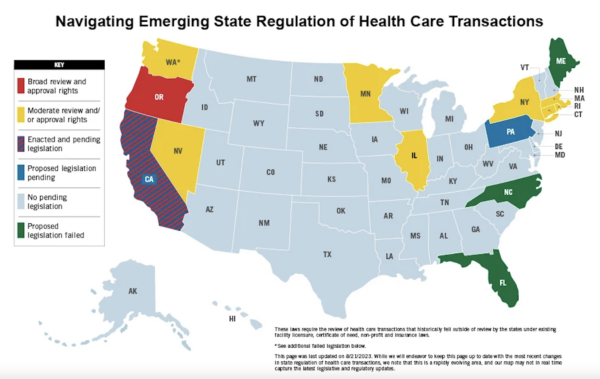
On August 31, California’s Office of Health Care Affordability (OHCA) will close the public comment period regarding proposed regulations under a new law that is aimed at providing oversight of certain healthcare M&A deals in the state next year.
According to OHCA, the goal is to address gaps in the “oversight of health care consolidation.” The Golden State’s attorney general has approval authority over the merger of nonprofit healthcare organizations and the Department of Managed Health Care has similar authority over transactions involving healthcare services plans. Meanwhile, the California Department of Insurance has approval authority for mergers of the state’s health insurers.
But that leaves gaps in the following areas, according to Andrew DiLuccia, a public information officer in the director’s office of the California Department of Health Care Access and Information.
They include transactions involving:
- For-profit hospitals and health facilities, among physician organizations
- Health plan or health insurer purchase or affiliation with another healthcare entity, such as a physician group
- Health plans or health insurers and management service organizations (MSOs) Involving Private Equity
- Exclusive contracting
Starting January 1, organizations falling under the above description and of a certain financial size will need to send a formal notice 90 days before any major change in the ownership or control of that covered entity’s assets or operations.
“This transaction review process was part of broader legislation that was passed last year, whose overarching purpose is to try to control the growth of healthcare costs in California,” explained Charles Oppenheim, partner at Hooper, Lundy & Bookman, a healthcare-focused legal firm. “So the statute had multiple pieces to it, and this transaction review process is just one component of that statute. And I assume that the broader purpose of it is to shine a spotlight on transactions that potentially could reduce competition in the marketplace.”
If OHCA determines that a potential transaction will have a significant impact that negatively affects consumers in terms of market conditions or cost, the office will engage in an extensive CMIR or “cost and market impact review. ” And the entity that sends the notice of a pending transaction will need to wait until completion of this final report before completing the transaction. It’s important to note that OHCA has no power to block the actual closing of a transaction.
So what is a covered healthcare entity that has to comply per the proposed regulations? According to an analysis by Hooper, Lundy & Bookman they would include:
(i) payers, such as Knox-Keene plans; (ii) providers, including health facilities, clinical laboratories, and physician organizations; and (iii) fully integrated delivery systems. (Certain categories of agreements or transactions are exempted from OHCA’s notice requirement, such as those reviewed by other [state] regulatory agencies.)
The law firm explained that these proposed regulations would “narrow this scope to cover only such health care entities (i) with annual revenue or California assets of at least $25 million, (ii) with annual revenue or California assets of at least $10 million involved in a transaction with a health care entity with annual revenue or California assets of at least $25 million, or (iii) that are located in or serve at least 50% of patients residing in a “health professional shortage area.”
However, on the flip side the definition of the a healthcare entity is actually being expanded by the proposed regulations, the law firm stated. So it now can include management services organizations as well as any affiliates, subsidiaries, or other entities that “control, govern, or are financially responsible for the health care entity or that are subject to the health care entity’s control, governance, or financial control.”
Not everything in the proposed legislation is clear — for instance, does it apply to out-of-state entities that want to buy a California organization?
“That’s a good question,” Oppenheim said. “I think that the legislation is intended to cover things that happen in California, which could involve a California entity being acquired by an out-of-state entity or a California entity doing a transaction with another California entity. I think some of that needs to be clarified a little bit because in some of the parts of the proposed regulations, there’s specific references to California revenue or California this or that, but other parts don’t have the same verbiage, and so I think that is going to create some uncertainty.”
Oppenheim added that he expects the regulation to add to business costs as healthcare organizations will have to hire expert help to submit the transaction notice to OCHA. He also expects a chilling effect as a result of this, though he couldn’t say whether other states like Massachusetts that has enacted similar legislation has seen a reduction in M&A deals caused by regulatory burden.
However, the OHCA has no power to block transactions. If so, then does this office have any teeth at all?
“Well, I guess it depends what you mean by teeth,” Oppenheim countered. “It’s going to slow transactions down and some transactions are going to be subject to a more comprehensive review, and then the agency will issue a report which might, in some cases indicate the agency’s belief that the transaction will reduce competition or increase costs in the marketplace, in which case one can anticipate that the California Attorney General might get involved if they’re not already. And so they would be the ones, I guess, that have more teeth, so to speak.
California is not the only state that is seeking to bring a level of oversight to healthcare consolidation. Below, is a map, created by law firm Ropes & Gray of states with various levels of regulation of healthcare deals. (Click to enlarge)
Photo: sesame, Getty Images














